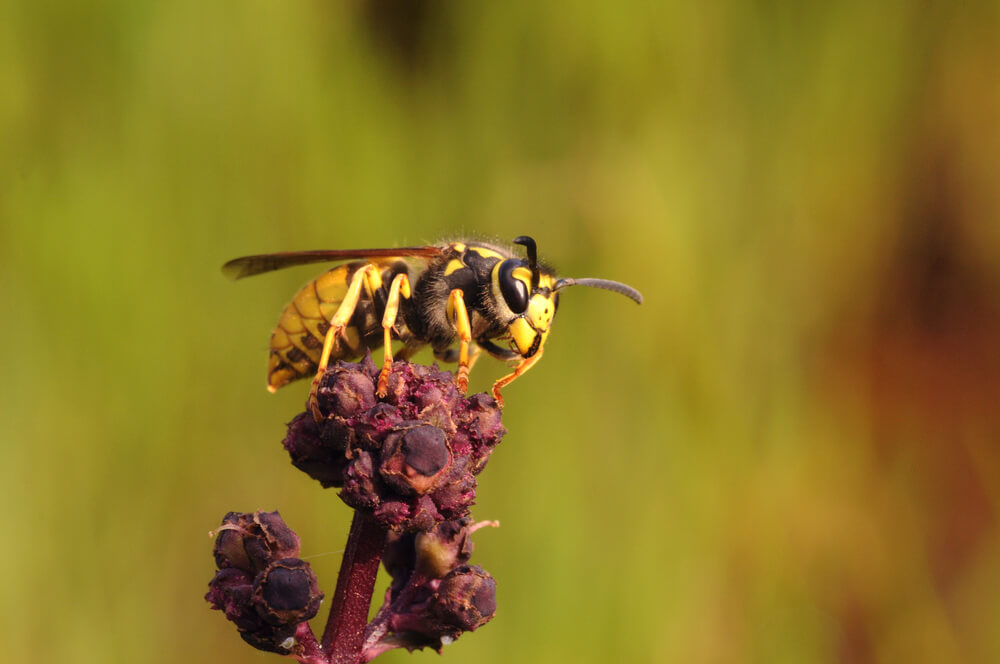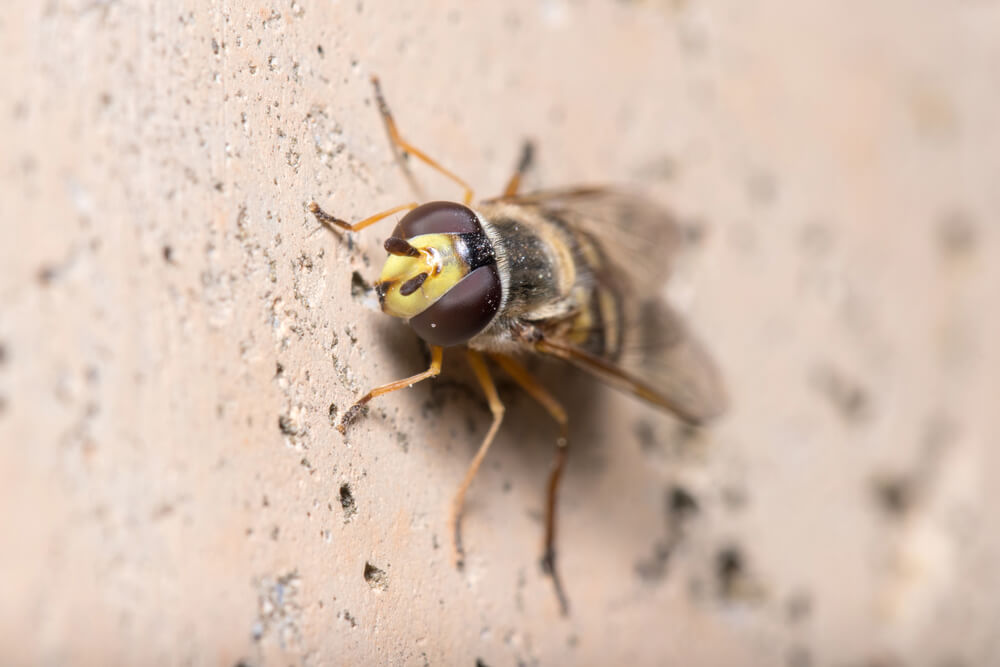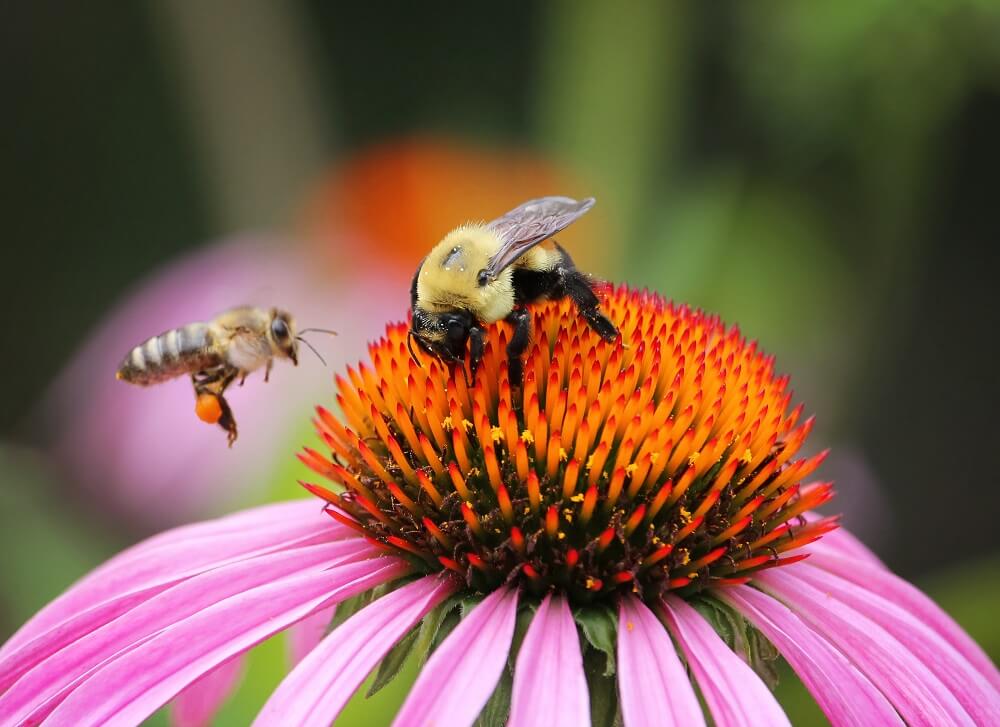Table of Contents:
Do Yellowjackets Sting or Bite?
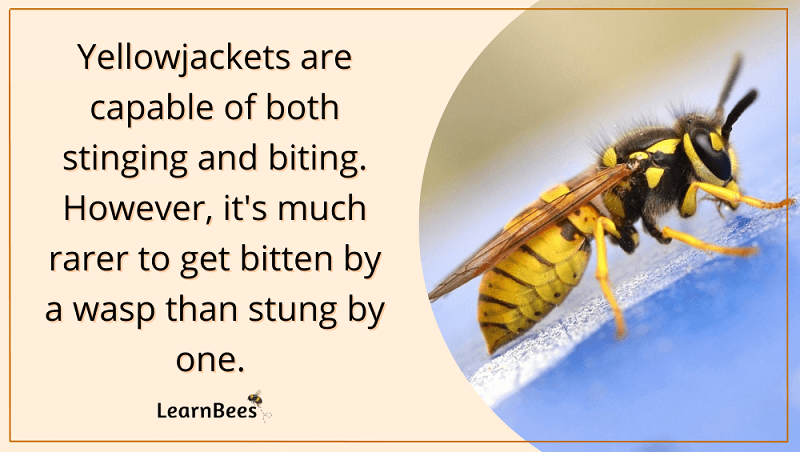
Yellowjackets can both sting and bite. However, humans are more likely to get stung by yellowjackets than bitten by them.
Why?
Because the stinger is the most powerful weapon a wasp or bee has.
As such, if yellowjackets sense danger, it’s their natural instinct to sting instead of bite. They typically only bite critters too small to sting – such as other insects.
But as with most things in life, there are exceptions to the rule.
In rare cases, a human can get bitten by a yellowjacket. This typically occurs when a yellowjacket bites the skin to allow them to have a better grip before stinging. Yellowjackets have mandibles (jaws) with jagged “teeth.”
But here’s the thing:
A wasp’s teeth aren’t the same as human teeth. They’re actually just sharp, narrow points that are extensions of the mandibles.
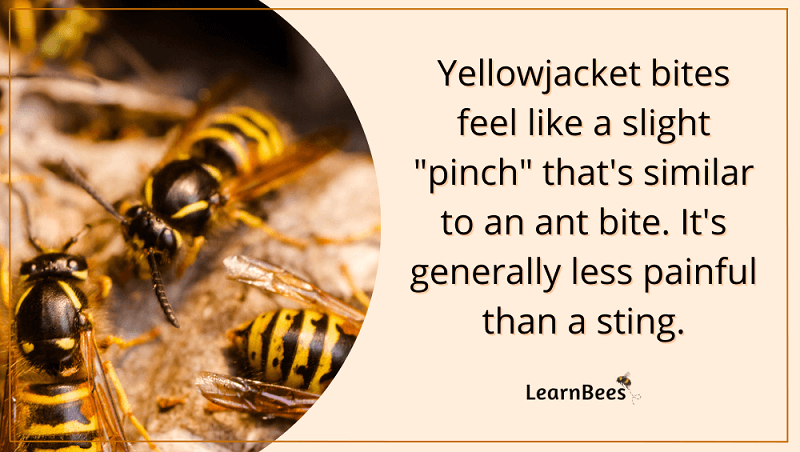
Now here are the million-dollar questions:
What does a yellowjacket bite feel like? Do yellowjacket bites hurt?
Yellowjacket bites feel like a “pinch,” similar to an ant bite. Yellowjacket bites don’t hurt much, but it’s still enough to take notice. The good news is that yellowjacket bites aren’t severe enough to leave welts or marks behind.
Now people often ask, “What’s the difference between a yellowjacket bite and a sting?”
They’re totally different.
Yellowjacket bites rarely happen and are mild in cases where they occur. On the other hand, yellowjacket stings can be somewhat painful and leave a small welt behind.
In most adults and children, the pain from yellowjacket stings subsides within four to six hours after the sting. Both redness and swelling should greatly decrease by then. It’s normal to experience itching for several days after the stinging takes place.(1, 2)
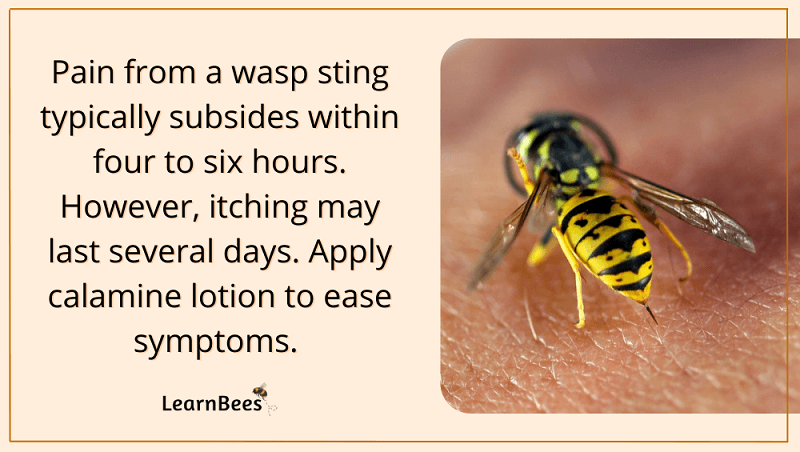
To help with the irritation and itch:
First, wash the sting site thoroughly with soap and water. Next, rub a thin layer of calamine lotion or hydrocortisone cream on the area.
And remember:
Yellowjackets don’t leave their stinger in the skin like honey bees do. So you won’t have to worry about removing the stinger. If you see a stinger lodged into your skin, it means you were stung by a honey bee, not a yellowjacket.
Yellowjackets and honey bees are often mistaken for each other since they share similar coloring and size.
With that in mind, it’s important to note that the pain from yellowjacket stings can vary.
For instance, there’s a difference between a “thin skin” and a “thick skin” yellowjacket sting.
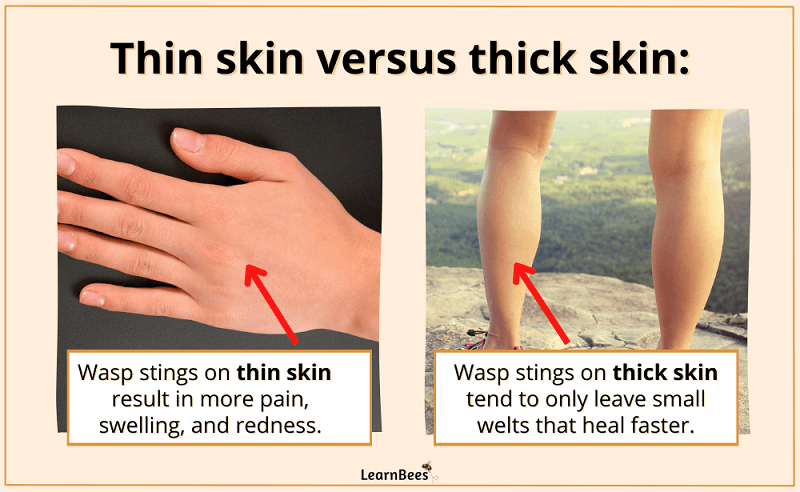
Thin skin stings swell more, hurt more, and take longer to heal. Thin skin stings happen on delicate skin, such as the tops of your feet, the back of your hands, and your ears.
The good news?
Thick skin yellowjacket stings heal faster with less pain. Examples of thick-skin yellowjacket stings happen on the thigh, calf, or stomach.
Some people may be highly allergic to yellowjacket stings in rare cases. This is known as anaphylaxis and is considered a potentially life-threatening reaction.(3, 4)
You should seek medical attention immediately if you experience swelling and difficulty breathing after being stung.(5)
Do Yellowjackets Sting for No Reason?
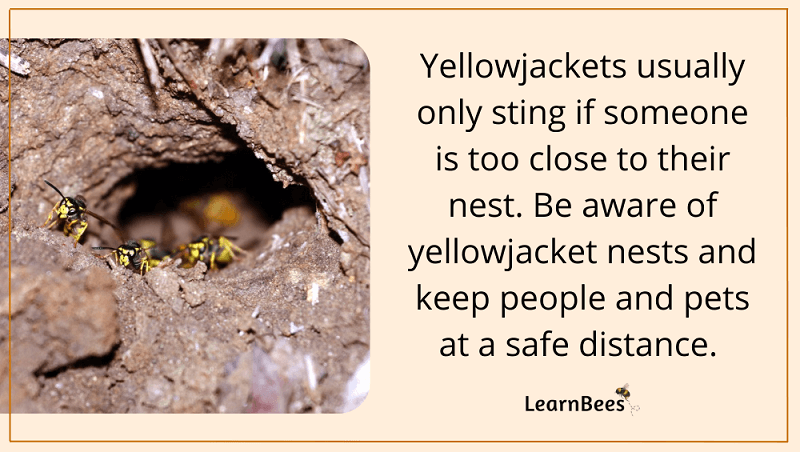
Despite popular belief, yellowjackets usually don’t sting for no reason. Instead, they’re most likely to sting someone if they’re near their nest.
But let’s face it.
Yellowjackets have a terrible reputation.
We’re made to believe that yellowjackets are out to get us. These big, bad stinging insects will stop at nothing until they kill our loved ones and us. Heck, they’ll even kill the family dog while they’re at it.
The truth, though?
Most people can avoid yellowjacket stings by giving them space away from their nest.
Yellowjackets nest underground in empty rodent holes or vegetation piles. They have large colonies of up to 15,000 wasps in them. This means you’ll typically see yellowjackets flying around their nesting site, making it easier to spot.
Now I won’t sugarcoat it:
Getting stung by yellowjackets isn’t fun. So, keeping people and pets away from yellowjacket nests is important.
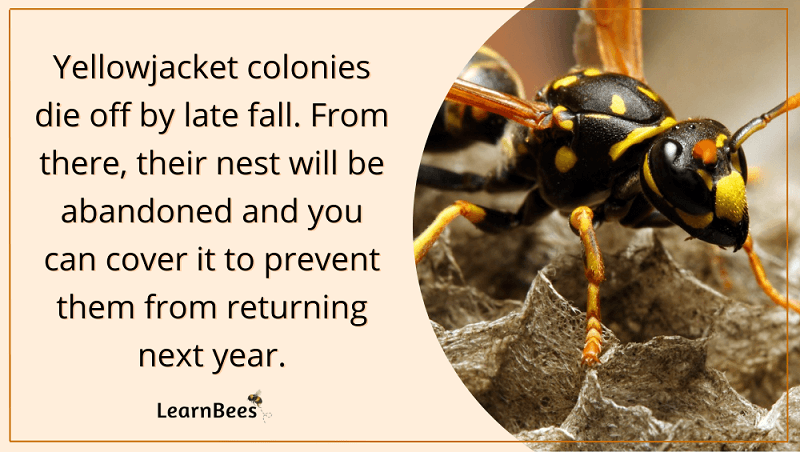
If you can, avoid the area where the yellowjackets are nesting. Yellowjacket colonies die off by late fall. From there, you can cover the nest to prevent them from returning next year.
Here’s the thing:
Yellowjackets are protective over their nests because they face many predators. Animals like skunks and raccoons can destroy their nest within minutes.
More importantly?
Yellowjackets are vital pollinators that are necessary parts of our ecosystems.
In fact, over 150 plant species depend on wasps for pollination. Certain plants have even adapted special strategies to attract wasps. For instance, warty hammer orchids (Drakaea livida) entice male wasps by imitating the smell and look of female wasps.(6)
But that’s not all.
Wasps are crucial pollinators to nearly 1,000 fig trees.(7, 8)
Fresh figs taste like berries dipped in a honey glaze. They’re healthy, delicious, and a staple in warm climates like California and the Mediterranean.
Better yet?
Yellowjackets not only pollinate, but they also help eat invasive bugs that overrun our food crops.
Beetle larvae, cabbage worms, and aphids cause severe damage to fruit and vegetables. As such, farmers and gardeners increasingly turn to yellowjackets to control pests.
Do Yellowjackets Die After They Sting?
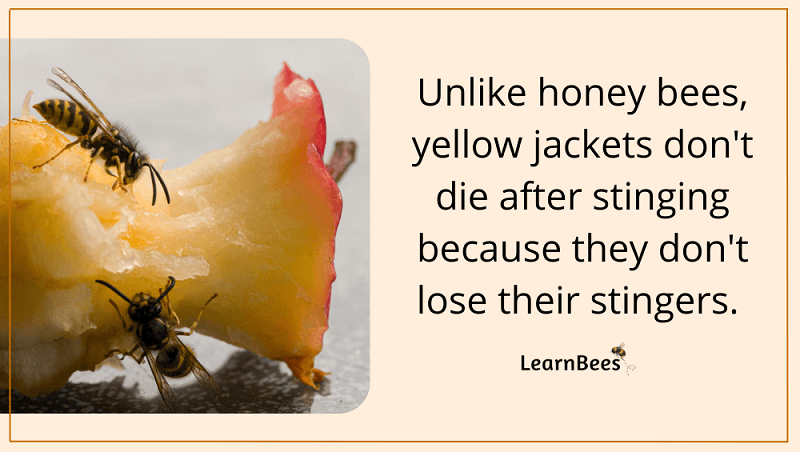
Yellowjackets don’t die after stinging.
Unlike honey bees, yellowjackets have “smooth” stingers that don’t get lodged inside human skin. This means they can sting multiple times.
Honey bees are different.
Honey bees have barbed stingers that get stuck in our skin. As a result, they die after stinging because they lose their stinger during the process. Unfortunately for honey bees, their stinger is attached to vital organs.
So when a honey bee’s stinger gets pulled out, it also pulls out the bee’s abdomen.
The end result?
The honey bee dies within minutes of stinging a person.
This is why you often must remove honey bee stingers from your skin. You don’t have to remove yellowjacket stingers because they don’t get left behind.
FAQs on “Do Yellowjackets Sting or Bite?”
- What happens when yellowjackets bite you?
- What does a yellowjacket bite feel like?
- How do you tell if it’s a yellowjacket bite or a sting?
- Do yellowjacket stings hurt worse than bee stings?
- Should I be worried if I got bitten by a yellowjacket?
- Should I be worried if I got stung by a yellowjacket?
- How many times can one yellowjacket sting you?
- Do yellowjackets bite unprovoked?
- Is a yellowjacket or wasp sting worse?
- How long does it take for a yellowjacket sting to stop stinging?
- What does a yellowjacket sting look like?
- Can yellowjackets kill you?
What happens when yellowjackets bite you?
Yellowjacket bites are rare. However, it feels like a slight pinch, similar to an ant bite. Yellowjacket bites aren’t considered incredibly painful for most people.
—> Go back to the FAQs on “Do Yellowjackets Sting or Bite?”
More to Explore:
What does a yellowjacket bite feel like?
A yellowjacket bite feels like a sharp pinch. It’s similar to an ant bite regarding pain level but also depends on your pain tolerance.
—> Go back to the FAQs on “Do Yellowjackets Sting or Bite?”
More to Explore:
- What’s the Difference Between Wasps, Hornets, and Bees?
- Wasp Nest vs. Bee Nest: Which One Is It?
- Wasps vs. Honey Bees: Are They Different?
How do you tell if it’s a yellowjacket bite or a sting?
Yellowjacket stings are much more common, while bites are rare.
Yellowjacket stings are more painful and often leave a red welt or mark behind. Pain typically reduces within four to six hours after the sting. Redness and itch can be common symptoms that can last several days.
After cleaning the sting site area, apply a thin layer of an over-the-counter hydrocortisone cream or calamine lotion to reduce any pain and inflammation.
—> Go back to the FAQs on “Do Yellowjackets Sting or Bite?”
More to Explore:
Do yellowjacket stings hurt worse than bee stings?
Yellowjacket stings typically feel comparable to bee stings in terms of pain.
—> Go back to the FAQs on “Do Yellowjackets Sting or Bite?”
More to Explore:
Should I be worried if I got bitten by a yellowjacket?
Most people shouldn’t be worried after experiencing a yellowjacket bite. Serious reactions to yellowjacket bites are rare. However, you should seek medical attention if you experience hives, difficulty breathing, or swelling.
—> Go back to the FAQs on “Do Yellowjackets Sting or Bite?”
More to Explore:
Should I be worried if I got stung by a yellowjacket?
Most people aren’t severely allergic to yellowjacket stings, so they shouldn’t worry. Pain and redness will typically resolve within a few hours to days.
You should seek medical care if you experience difficulty breathing, hives, or symptoms that don’t resolve within a week.
—> Go back to the FAQs on “Do Yellowjackets Sting or Bite?”
More to Explore:
How many times can one yellowjacket sting you?
Yellowjackets can sting as often as they want since they don’t die after stinging.
—> Go back to the FAQs on “Do Yellowjackets Sting or Bite?”
More to Explore:
Do yellowjackets bite unprovoked?
Yellowjackets typically bite or sting when someone gets close to their nest. Additionally, yellowjacket bites are extremely rare.
—> Go back to the FAQs on “Do Yellowjackets Sting or Bite?”
More to Explore:
Is a yellowjacket or wasp sting worse?
Yellowjackets are actually a species of wasp. In terms of pain, wasp, and yellowjacket stings are similar.
—> Go back to the FAQs on “Do Yellowjackets Sting or Bite?”
More to Explore:
How long does it take for a yellowjacket sting to stop stinging?
Pain and redness from a yellowjacket sting typically resolve in four to six hours. Itching is a common symptom lasting up to five or seven days. Applying calamine lotion or hydrocortisone cream to the affected area can reduce pain or inflammation.
—> Go back to the FAQs on “Do Yellowjackets Sting or Bite?”
More to Explore:
What does a yellowjacket sting look like?
A yellowjacket sting typically looks like a red, swollen bump on the skin. It’s often accompanied by pain and itching.
—> Go back to the FAQs on “Do Yellowjackets Sting or Bite?”
More to Explore:
Can yellowjackets kill you?
A yellowjacket sting can be life-threatening if you’re seriously allergic to wasp stings, such as anaphylaxis. Additionally, multiple yellowjacket stings can be life-threatening if you’re stung by a swarm of them.
It’s essential to seek medical attention immediately if you’re stung by a large swarm or experience any allergic reaction symptoms. Otherwise, yellowjacket stings won’t cause long-term damage or death.
